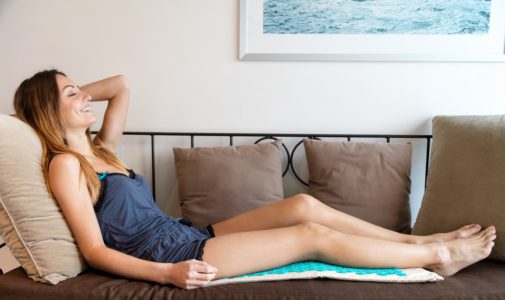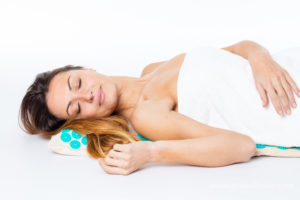
How can acupressure help eliminate cellulite?
As the warmer weather approaches, the same issue always arises: how to dress to conceal cellulite without feeling too hot? Skirts, shorts—once seated, thighs can be visible! Long skirts, sleeveless tops—for the arms, they can also be revealing!
Beyond the aesthetic discomfort, cellulite can be painful and may indicate deeper issues such as water retention, poor blood circulation, or a sluggish lymphatic system.
While dietary adjustments and physical activity are primary recommendations for reducing cellulite, they often aren’t sufficient. Techniques like massage and self-massage, such as the kneading technique, are often necessary.
Did you know that acupressure can help smooth out cellulite?
How can acupressure act on cellulite?
- By promoting blood circulation and facilitating lymphatic drainage
- By providing effective self-massage
- Additionally, it relieves heavy legs associated with poor blood circulation, which can contribute to cellulite.
1. Acupressure cushions and mats boost blood circulation and lymphatic system
Placed under the legs, the 6930 acupressure points of the mat will exert uniform pressure on the legs, thereby stimulating blood circulation and lymphatic drainage. To better visualize this, imagine squeezing a straw filled with water: the pressure applied would expel the water more vigorously than if it were left to flow on its own.
If you notice edema primarily in your calves due to water retention, you can use the acupressure cushion and place it under your calves while sitting or lying down. When choosing the filling, consider that spelt will be quite firm whereas millet will be softer. Both fillings are effective; choose based on your desired comfort.
Poor skin tissue health is a crucial factor in cellulite. Weakened skin is more prone to cellulite formation. Stimulating blood circulation will enhance oxygenation of cells and deliver necessary nutrients, while promoting toxin elimination.
2. Acupressure cushions and mats for self-massage
We’ve all come up against a wall when we’ve asked for a massage… Then rely on your acupressure cushion or mat! As with an energetic massage, your skin will turn red during and after your acupressure session. This is a sign of an influx of blood, and therefore an increase in cellular exchanges! The blood will transport fat cells to the mitochondria, the fat-burning centres, thereby promoting lipolysis (fat melting).
In addition, the pimples on the acupressure mat will undoubtedly help to restore equality between men and women. They will exert vertical pressure on the skin, helping the movement of female adipocytes!
3. Acupressure cushions and mats relieve heavy legs
When linked to poor blood circulation, cellulite can cause a sensation of heavy legs. This sensation is linked to an accumulation of blood in the legs. By boosting blood circulation, acupressure encourages the return of blood to the upper part of the body.
Walking is also a very good alternative for relieving heavy legs, but is not always suitable for everyday activities. Office jobs are a good example of a sedentary lifestyle: you spend all day sitting in front of your computer and by the time you leave, your legs are weighing a ton! That’s why we recommend the Climsom Zen acu-reflexology cushion. It sits under your feet and provides the ideal density to mimic walking. Hidden under your desk, bounce on the cushion to encourage venous return!
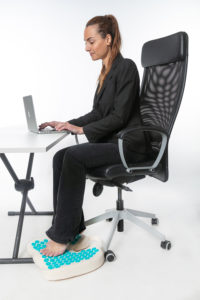
So smoothing out cellulite is not impossible! However, it takes time and, above all, it has to be done regularly! Good habits need to be adopted to limit the appearance of new cellulite: diet, sport… Climsom Zen will help you with this routine to help eliminate cellulite, while at the same time offering you real relaxation sessions! Make yourself comfortable and enjoy a session that’s relaxing on the one hand, and effective on the other!
Find out more about cellulite…
What are the different forms of cellulite?
Adipose cellulite
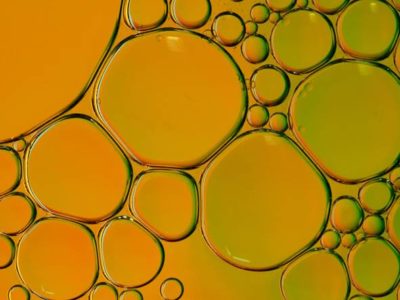
Adipose cellulite is linked to saturation of fat cells with fat and sugar. This form of cellulite is rather soft and not painful to the touch. It generally appears on parts of the body between the hips and knees (thighs and buttocks in particular).
Aqueous cellulite
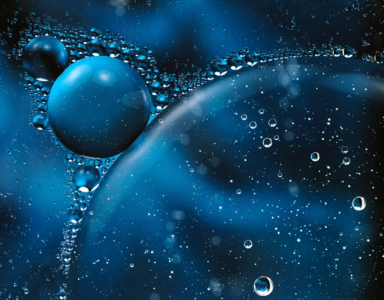
Aqueous cellulite is caused by water retention. The accumulation of water within the tissues forms swellings (oedemas) mainly in the legs and ankles. These oedemas, encouraged by prolonged static sitting or standing, can in turn lead to a feeling of heavy legs.
Aqueous cellulite is less supple than adipose cellulite, but can be sensitive when highly developed. It creeps into the lower part of the body but can also reach the arms.
Fibrous cellulite
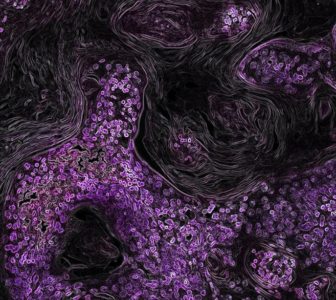
Fibrous cellulite is the cellulite that is most firmly anchored in the skin. In this case, it is the collagen cells that have joined with the glucose and hardened under the skin. This cellulite is much firmer and painful to the touch. It appears particularly on the knees and thighs.
How does cellulite appear?
Fat cells (adipocytes) are organised in clusters in the hypodermis (the layer of skin below the dermis and epidermis). When the fat cells are too large, they break through the tissue and form small bumps on the surface of the skin: this is known as orange peel skin! In the case of aqueous cellulite, it is the other skin cells that become waterlogged and cause these small bumps.
Clusters of cells, orange peel skin… not your dream fruit salad!
Why don’t fat cells surface in men?
In women, adipocytes are organised perpendicular to the skin, whereas in men these cells are more oblique. As a result, when they get bigger, female fat cells tend to stick out, whereas male fat cells are more likely to slip out.
What’s more, women’s skin is thinner, which makes this phenomenon all the more visible.
What can we deduce from the existence of these 3 forms of cellulite?
1 – We are not all equal when it comes to cellulite
Cellulite affects 90% of women, compared with an average of just 2% of men. This inequality has a hormonal origin: oestrogen encourages the appearance of cellulite. In addition, the nature and organisation of women’s skin cells make cellulite more visible.
Cellulite can also be hereditary, so thank your family!
2 – Cellulite is not always due to a weight problem
Although there is a correlation between fat cells and cellulite, circulatory problems and water retention are not linked to weight. A slim person can still suffer from watery cellulite, for example.
3 – Cellulite is not irreversible
Unsightly and uncomfortable? The good news is that cellulite goes away!



